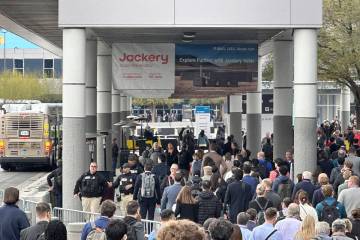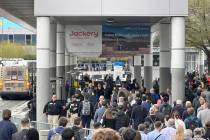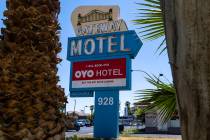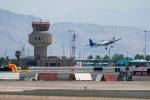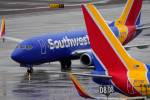Officials trim airport plans
In a nod to the shabby economics of the airline industry, officials at McCarran International Airport in Las Vegas will trim about $360 million from a $3.7 billion capital improvement plan.
Clark County commissioners voted unanimously on Tuesday to defer or eliminate 10 projects from the five-year plan.
They did, however, preserve a $114 million heliport that will shift Grand Canyon tour operators away from McCarran to reduce the number of helicopters that fly over homes, an issue several commissioners said is important to voters.
Delaying the heliport was among the money-saving recommendations Clark County Aviation Director Randall Walker proposed and would have increased the amount of cutbacks to $475 million.
"As long as I am around, I am going to vociferously fight to keep that heliport going," Commissioner Bruce Woodbury said.
Walker later said construction of the heliport, to be built near Sloan, could start as early as August 2009 and be ready for use two years later.
The idea of the heliport is to induce tour operators -- who have a right to use McCarran as long as they meet certain airport requirements -- to move to a more remote location.
Without a heliport, tour operators could exercise their rights to move to Henderson Executive Airport to escape congestion and expense of using McCarran, the nation's seventh-busiest passenger airport.
If they did that, a heliport might never be viable.
"I doubt we could build anything that could entice them to leave Henderson," Walker said.
Commissioner Chris Giunchigliani said pushing forward with the heliport despite airlines' desire to cut costs would be worth the money if it kept tour operators from moving to Henderson and preserved the political and financial capital already expended to build a new project in Sloan, away from neighborhoods.
"It has been a long time coming," she said. "We don't want to shift the problem."
The heliport was the only item on the original list of 11 cutbacks the commissioners decided to preserve.
Projects that were delayed included reconstruction of runway 25R, which would have cost $215 million. The asphalt runway is safe, but requires more maintenance than a new runway because aircraft tires form ruts in the surface. Airport workers need to monitor the surface constantly and smooth the ruts when they reach a certain depth, Walker said.
Other delayed projects include a $6 million curbside sign proposal and $9.3 million baggage-handling system that would smooth coordination between bag handling and security.
The only eliminated item was a $10 million expansion of escalators to the baggage claim.
The deferred items can be considered again in the 2013 capital improvement plan or sooner if the economic outlook improves. The cutbacks were the result of a request by airlines that use the airport.
Airlines, which are being hit hard by increased fuel prices and decreased travel, asked Clark County officials to scrutinize the capital improvement plan, which is largely funded by fees charged to airlines.
In a letter airlines sent in July, they asked airport officials and the county to slow development of a third terminal, then estimated to cost about $1.8 billion.
"What we want is to have the whole project assessed, and that is due to $145-per-barrel oil," Bob Montgomery, vice president of properties for Southwest, the biggest carrier to Las Vegas, said at the time.
County officials continued with the terminal plan by authorizing a $1.2 billion contract for the terminal building. The cost estimate for the whole project has since revised up to about $2.4 billion.
But they promised to scrutinize other projects, which resulted in the recommendations by Walker on Tuesday.
In addition to trimming the capital budget, the county commissioners approved a plan to revise about $240 million in bond debt from 2005.
As a result of the crashing real estate market, the company that insured the bonds lost its AAA rating, which increased the interest rate.
The commissioners approved a request to replace the insurance with a bank letter of credit, which will save about 1 percent in financing costs.
The cost to make the move will be recovered in 309 days, Walker said.
Contact reporter Benjamin Spillman at bspillman@reviewjournal.com or 702-477-3861.





